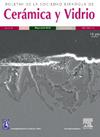碳热还原法制备SiC-ZrC复合粉体及其高温抗氧化性能
IF 2.7
4区 材料科学
Q1 MATERIALS SCIENCE, CERAMICS
Boletin de la Sociedad Espanola de Ceramica y Vidrio
Pub Date : 2025-09-26
DOI:10.1016/j.bsecv.2025.100469
引用次数: 0
摘要
超高温陶瓷材料在极端环境中具有不可替代的价值,其中SiC-ZrC多相陶瓷因其优异的高温性能成为研究热点。高质量复合粉体的合成是制备高性能陶瓷的关键。为了解决传统碳热还原方法的局限性,包括有机碳源的杂质污染,反应稳定性不足,以及SiC-ZrC复合粉末的氧化行为和双相协同机制研究的缺乏,本研究开发了一种新的可控碳热还原工艺,使用高纯度石墨作为碳源(氩气,1400-1600°C)。系统地研究了煅烧温度对粉末的相组成、微观结构和元素分布的调节作用。此外,还进行了空气环境下的高温氧化实验,揭示了粉末的氧化行为特征和双相协同机理。结果表明,在1600℃、保温时间1.5 h的条件下,可成功合成元素分布均匀的高纯度SiC-ZrC复合粉体。在高温氧化过程中,SiC表现出明显优于ZrC的抗氧化性:ZrC早在800℃就开始氧化形成ZrO2,而SiC即使在1500℃也能保持优异的结构稳定性。两相通过形成SiO2-ZrO2复合氧化层和ZrSiO4相实现协同氧化增强。本文章由计算机程序翻译,如有差异,请以英文原文为准。
Preparation of SiC–ZrC composite powders by carbothermal reduction method and its high-temperature oxidation resistance performance
Ultra-high temperature ceramic materials possess irreplaceable value in extreme environments, among which SiC–ZrC multiphase ceramics have emerged as a research focus due to their exceptional high-temperature performance. The synthesis of high-quality composite powders is pivotal for the fabrication of high-performance ceramics. To address the limitations of conventional carbothermal reduction methods—including impurity contamination from organic carbon sources, inadequate reaction stability, and the paucity of research on the oxidation behavior and biphase synergistic mechanisms of SiC–ZrC composite powders—this study developed a novel controlled carbothermal reduction process using high-purity graphite as the carbon source (argon atmosphere, 1400–1600 °C). Systematic investigations were conducted to elucidate the regulatory effects of calcination temperature on the phase composition, microstructure, and elemental distribution of the powders. Additionally, high-temperature oxidation experiments under air atmosphere were performed to reveal the oxidation behavior characteristics and biphase synergistic mechanisms of the powders. The results demonstrate that high-purity SiC–ZrC composite powders with uniformly distributed elements can be successfully synthesized at 1600 °C with a 1.5-h holding time. During high-temperature oxidation, SiC exhibits significantly superior oxidation resistance compared to ZrC:ZrC initiates oxidation to form ZrO2 as early as 800 °C, while SiC retains excellent structural stability even at 1500 °C. The two phases achieve synergistic oxidation enhancement through the formation of SiO2–ZrO2 composite oxide layers and ZrSiO4 phases.
求助全文
通过发布文献求助,成功后即可免费获取论文全文。
去求助
来源期刊

Boletin de la Sociedad Espanola de Ceramica y Vidrio
工程技术-材料科学:硅酸盐
CiteScore
5.50
自引率
2.90%
发文量
72
审稿时长
103 days
期刊介绍:
The Journal of the Spanish Ceramic and Glass Society publishes scientific articles and communications describing original research and reviews relating to ceramic materials and glasses. The main interests are on novel generic science and technology establishing the relationships between synthesis, processing microstructure and properties of materials. Papers may deal with ceramics and glasses included in any of the conventional categories: structural, functional, traditional, composites and cultural heritage. The main objective of the Journal of the Spanish Ceramic and Glass Society is to sustain a high standard research quality by means of appropriate reviewing procedures.
 求助内容:
求助内容: 应助结果提醒方式:
应助结果提醒方式:


